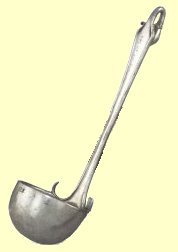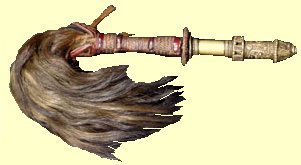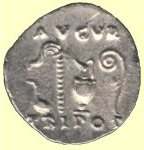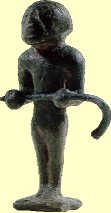Priestly implements.
A ladle with a long
handle used in religious ceremonies to pour out wine during sacrifices. This
ladle allowed the priests to taste the wine which they poured onto the head
of an animal destined for sacrifice. It was one of the insignia of the college
of pontiffs.


Praeferculum or Capis
A praeferculum is a tall vessel with
wide shoulders, a narrow flat bottom, with one looping handle and a spout.
It was usually made of earthenware and sealed with tar to make it waterproof.
An identifying emblem of an augur,
it is the jar in which he holds libations.

Lituus
The lituus was the wooden staff which
the augur would raise to the sky
to divided the expanse of heaven into regions (templum) when he would take
the auspices (observe the flights of birds). This form of divination was already
used by the Etruscans and that's where the lituus finds its origin. It is
one of the symbols of the augur and his authority. Legend records that Romulus
used a lituus at the time of Rome's foundation in 753 BC. Cicero
has left us a description of Romulus' lituus: "Est incurvum et
leviter a summo inflexum bacillum"; it is a staff, curved and slightly
bent at the top. The lituus of Romulus was kept by the Salii, a college of
priests, in the Curia Saliorum, on the Palatine Hill. After the temple was
burnt down by the Gauls the relic was miraculously found untouched by the
fire, all things around it being completely consumed and burnt.
